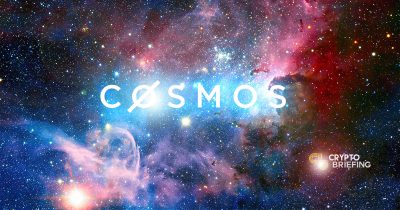What Is Cosmos? Introduction to ATOM Token
Even Ethereum is just an ATOM in the Cosmos

Share this article
What Is the Cosmos Network?
Cosmos (ATOM) is a decentralized ecosystem of independent blockchains that its creator, All In Bits Inc (dba Tendermint Inc), hopes is the foundation for the next generation of internet technology. Instead of participating in divisions between crypto factions, Cosmos brings them all together, enabling interoperability, currency exchanges, and an Internet of Blockchains (IoB). Atom (ATOM) is the proprietary staking coin used by the network and also tokenizes transactions.
The team essentially built two components to make this happen: Tendermint Core, and an Inter-Blockchain Communications (IBC) protocol. Together, they form the Cosmos Network.
- Tendermint Core – Tendermint is the open-source base layer that acts as a blockchain development platform. Anyone with an application can use this blockchain-in-a-box implementation to integrate their own decentralized/distributed network, along with their own BFT-compatible consensus model.
- Inter-Blockchain Communications (IBC) – The next layer is the interconnectivity layer that enables communication between all the individual chains. This creates a series of interconnected zones and hubs that act independently, yet share a common system architecture. This is the key layer for token, data, and digital asset exchanges across chains.
Cosmos integrates processing/verification hubs to keep everything running together. Hubs use a Proof-of-Stake (PoS) consensus to validate Tendermint transactions. The project gained traction in recent years, thanks in part to $9 million in VC funding from the likes of Paradigm, and Bain Capital. In fact, London-based KR1 reports Cosmos is its most successful investment, raising $360,605 off a $7,000 buy.
The Cosmos mainnet launched March 14, 2019. It’s hailed as a strong project, but it’s not without problems. A summer 2019 attack exposed a vulnerability that would be costly if not corrected. Still, the team’s vision of a global economy run on cryptocurrency is one shared by many expert analysts at this point.
Let’s start our exploration of this ambitious project with an analysis of ATOM, the native cryptocurrency token used by the Cosmos Network.
ATOM Token Cryptocurrency Summary
Cosmos has a total supply of 237,928,231 ATOM. Over $40 million worth of ATOM is traded on a daily basis, and the peak price so far was $8.31 on March 16, 2019.
Ths Cosmos ICO was held on April 6, 2019, raising $17.3 million worth of ETH, BTC, and USD. Approximately 75 percent of the available token supply was sold in the ICO, with 5 percent withheld for seed investors, and 10 percent each held by All in Bits and the Interchain Foundation.
ATOM isn’t mined. Instead, it’s earned via a hybrid PoS algorithm. The more ATOM staked, the more likely to become a validator node to validate a transaction and earn tokens, though it is also possible to delegate your tokens and receive a portion of the rewards.
If a node is found to be acting dishonestly, it’s removed immediately from the network and its ATOM balance is held for 21 days while the incidents are investigated. The staked coins are then destroyed. The summer 2019 attack removed the 21-day waiting period and allowed bad actors to remove tokens before they were destroyed.
ATOM is accepted on a wide variety of cryptocurrency exchange markets, including Binance, BitForex, Huobi Global, Dcoin, Kraken, Bibox, and OKEx. Trading pairs include BTC, ETH, USDT, and fiat currencies like EUR and KRW.
Into the Cosmos Network
Cosmos was initially conceived by Jae Kwon in 2014, and he was joined by Ethan Buchman a year later. They created the platform’s SDK to lower the barrier to entry for blockchain development and build a decentralized field for individual chains to communicate with each other.
Individual chains (which can represent decentralized applications, intranets, and more) are divided into zones and connected through Cosmos hubs. These hubs validate transactions and provide crosschain compatibility. This is what enables data and value transfers.
Each individual chain can choose and run its own independent governance. They have their own software stack (rooted in Tendermint Core through the Cosmos SDK), and they aren’t affected by the other zones. Pegged tokens (currently, a pegged Ethereum token called Ethermint is the only available Peg-Zone) are created to enable conversions between a Proof-of-Work (PoW) chain and the native PoS system in Tendermint Core.
With this sandbox environment, the Cosmos Network has all the development pieces in place, and it has a strong (and well-financed) team behind it. All it needs now is third-party partnerships and support. Of course, that’s a major piece that’s not easy to get.
Summary
Cosmos and Tendermint are a network of interconnect blockchains developed to become the foundation for tomorrow’s technology. It enables easy blockchain creation and deployment with crosschain compatibility. The project’s success hinges on these key factors.
- Cosmos is a dual-layer network that enables token, data, and asset exchanges between blockchains. Each chain on the network operates independently.
- Cosmos Hubs validate on-chain transactions and earn ATOM through staking. ATOM is the native cryptocurrency token of the Cosmos Network.
- New blockchains are created using the Cosmos SDK and Tendermint Core then connected through the IBC layer.
With these pieces in place, Cosmos is a well-built machine that can easily compete in the modern blockchain market. If the team negotiates a large third-party dApp library and gains enterprise buy-in, this could be a sleeping giant in blockchain.
Share this article
